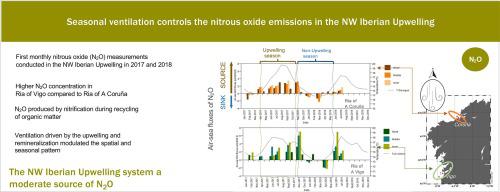当前位置:
X-MOL 学术
›
Prog. Oceanogr.
›
论文详情
Our official English website, www.x-mol.net, welcomes your
feedback! (Note: you will need to create a separate account there.)
Seasonal ventilation controls nitrous oxide emission in the NW Iberian upwelling
Progress in Oceanography ( IF 3.8 ) Pub Date : 2024-04-12 , DOI: 10.1016/j.pocean.2024.103261 Mercedes de la Paz , Fiz F. Pérez , Marta Álvarez , Antonio Bode
Progress in Oceanography ( IF 3.8 ) Pub Date : 2024-04-12 , DOI: 10.1016/j.pocean.2024.103261 Mercedes de la Paz , Fiz F. Pérez , Marta Álvarez , Antonio Bode

|
Despite their small spatial extent, coastal upwelling systems are an important source of oceanic nitrous oxide (NO) to the atmosphere. To date, hot-spot NO emissions have been reported for low oxygen waters of the eastern boundary upwelling systems at their tropical latitudes, but there is a limited number of studies in their “oxygenated” temperate latitudes. This is the first study of the NO cycle in the NW Iberian Upwelling system, where we investigated the seasonality of the NO concentrations and their emissions to the atmosphere, along with the spatial differences in this coastal region in response to the upwelling. Monthly observations were collected from February 2017 to July 2018, in two hydrographic sections within the Ría of Vigo and Ría of A Coruña, two coastal embayments with contrasting response to the upwelling of the Eastern North Atlantic Central Water (ENACW) in the region. NO concentrations ranged between 8.56 to 12.53 nmol kg (94–121 % of saturation) in the shelf, and from 8.62 to 17.60 nmol kg (94–203 % of saturation) inside the rías, with the highest NO concentration at the bottom, which increase as the upwelling progress from April to October. The air-sea fluxes of NO varied between −1.6 to 3.26 µmol m d in the shelf and −1.53 to 7.00 µmol m d inside the rías. Local differences on the ventilation and remineralization pattern drives the seasonality of NO and differences between Ria of Vigo and Ria of A Coruña, being the higher values of NO concentrations and air-sea fluxes registered in the inner Ria of Vigo. Our study reports the NO emissions of an upwelling system in a temperate latitude, where the upwelling waters are central waters relatively well ventilated in terms of oxygen content, behaving as a moderate low net source of NO to the atmosphere compared to tropical upwelling latitudes, characterised by a lower oxygen content.
中文翻译:

季节性通风控制伊比利亚西北部上升流中的一氧化二氮排放
尽管空间范围较小,但沿海上升流系统是大气中海洋一氧化二氮(NO)的重要来源。迄今为止,热带纬度东部边界上升流系统低氧水域的热点NO排放量已被报道,但对其“含氧”温带纬度的研究数量有限。这是对伊比利亚西北部上升流系统中 NO 循环的首次研究,我们研究了 NO 浓度的季节性及其向大气的排放,以及该沿海地区对上升流的响应的空间差异。 2017 年 2 月至 2018 年 7 月期间,在维戈河口和拉科鲁尼亚河口内的两个水文剖面收集了每月观测数据,这两个沿海海湾对该地区东部北大西洋中央水域 (ENACW) 的上升流的反应形成鲜明对比。陆架中的 NO 浓度范围为 8.56 至 12.53 nmol kg(饱和度的 94-121%),河口内部的 NO 浓度范围为 8.62 至 17.60 nmol kg(饱和度的 94-203%),其中底部的 NO 浓度最高,从 4 月到 10 月,随着上升流的进展而增加。陆架中 NO 的海气通量变化范围为 -1.6 至 3.26 µmol m d,流域内为 -1.53 至 7.00 µmol m d。通风和再矿化模式的局部差异驱动了 NO 的季节性以及维戈河口和拉科鲁尼亚河口之间的差异,即维戈内河口记录的 NO 浓度和海气通量较高。 我们的研究报告了温带纬度地区上升流系统的 NO 排放量,其中上升流水域是氧含量相对良好的中心水域,与热带上升流纬度地区相比,其表现为中等偏低的大气 NO 净源,其特征是通过较低的氧含量。
更新日期:2024-04-12
中文翻译:

季节性通风控制伊比利亚西北部上升流中的一氧化二氮排放
尽管空间范围较小,但沿海上升流系统是大气中海洋一氧化二氮(NO)的重要来源。迄今为止,热带纬度东部边界上升流系统低氧水域的热点NO排放量已被报道,但对其“含氧”温带纬度的研究数量有限。这是对伊比利亚西北部上升流系统中 NO 循环的首次研究,我们研究了 NO 浓度的季节性及其向大气的排放,以及该沿海地区对上升流的响应的空间差异。 2017 年 2 月至 2018 年 7 月期间,在维戈河口和拉科鲁尼亚河口内的两个水文剖面收集了每月观测数据,这两个沿海海湾对该地区东部北大西洋中央水域 (ENACW) 的上升流的反应形成鲜明对比。陆架中的 NO 浓度范围为 8.56 至 12.53 nmol kg(饱和度的 94-121%),河口内部的 NO 浓度范围为 8.62 至 17.60 nmol kg(饱和度的 94-203%),其中底部的 NO 浓度最高,从 4 月到 10 月,随着上升流的进展而增加。陆架中 NO 的海气通量变化范围为 -1.6 至 3.26 µmol m d,流域内为 -1.53 至 7.00 µmol m d。通风和再矿化模式的局部差异驱动了 NO 的季节性以及维戈河口和拉科鲁尼亚河口之间的差异,即维戈内河口记录的 NO 浓度和海气通量较高。 我们的研究报告了温带纬度地区上升流系统的 NO 排放量,其中上升流水域是氧含量相对良好的中心水域,与热带上升流纬度地区相比,其表现为中等偏低的大气 NO 净源,其特征是通过较低的氧含量。











































 京公网安备 11010802027423号
京公网安备 11010802027423号